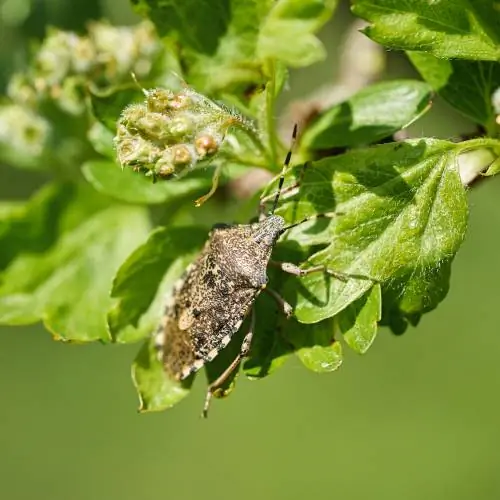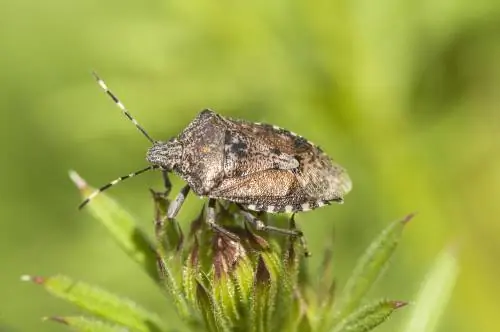- Author admin [email protected].
- Public 2023-12-16 16:46.
- Last modified 2025-06-01 06:02.
Fire bugs don't have a good reputation. This negative image comes from related species of bugs that cause problems for gardeners. But the way of life of fire bugs turns out to be exciting in many ways. In most cases, control is unnecessary.
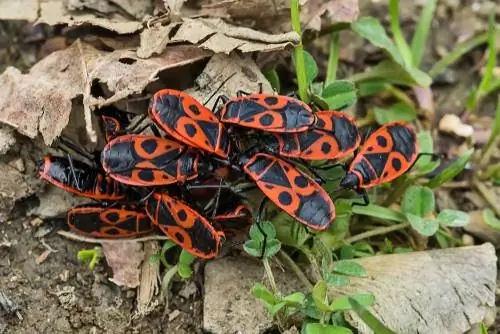
Are fire bugs poisonous?
Fire bugs pose no danger to humans. You don't have to worry about being bitten when you pick up the insects. The animals are not poisonous. If dogs or cats accidentally attack the animals, they are quickly put off by the unpleasant taste. Even brave pets learn from such experiences.
Fighting fire bugs
Most of the time it is not necessary to fight the animals. The haunting is often over after a few weeks, as the animals are only active between March and May. If the winters are particularly harsh, most animals cannot survive. In many cases the occurrence is limited in time.
Clear accumulations
In early spring, look for obvious hiding places such as stone slabs and piles of leaves on trees. If the sun has not yet warmed up such retreats, fire bugs will only come out of hiding later. This way you can move the clumps of bugs into a bucket and release them again at a safe distance at the edge of the forest. Wear gloves to avoid getting the animal's defensive secretions on your skin.
In the house
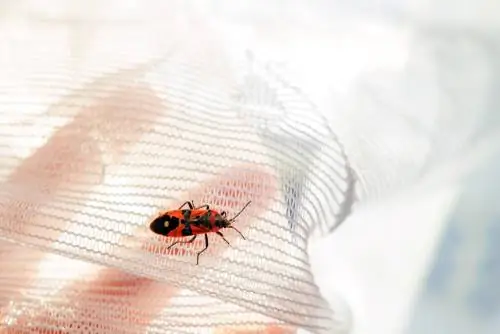
If you find a fire bug in your house, you should carefully take it outside
It occasionally happens that fire bugs crawl into the apartment through open windows or under door slits. But you don't have to worry about the animals taking over your bed. Fire bugs do not thrive in unnatural environments. They get lost there when they are distracted by smells or are looking for a place to retreat. You can guide individual animals onto a piece of paper and take them outside.
Gentle option for removal:
- Put the screw cap glass over the bug
- Place a sheet of paper underneath
- Put the bug into the jar
- expose far away from home
If you crush a fire bug in your home, you risk unsightly stains and an unpleasant smell.
Chemical antidotes
You should avoid using industrially produced products with aggressive ingredients. Such insecticides do not only control fire bugs, as they do not work selectively. The products destroy the entire insect world in the garden, so that other useful animals are also killed. If the substances get into nearby bodies of water or the ground, they affect other living beings. Chemical clubs create an imbalance in the ecosystem and should not be used if possible.
Natural control and home remedies
If the presence of fire bugs is still undesirable, you can fight or scare away the animals naturally. The methods protect the environment and are not harmful to he alth. However, these methods should also be used carefully and solutions used sparingly.
Soap suds
An effective control agent that is environmentally friendly and has a targeted effect is a solution made from biodegradable soap and water. Fill a spray bottle with water and squirt a few drops of dish soap into the water. A little curd soap achieves the same effect. Shake the bottle well until the soap dissolves.
You can then spray the solution onto the bedbug clusters. A fine mist is enough for the animals to die within a few minutes. The soapy water dissolves the protective layer of the shell. Without this protective layer, the bugs dehydrate.

Sprayed with soapy water, the beautiful animals die a painful death
Tip
You can also use diatomaceous earth. The fossil rock consists of aluminum, silicon and iron and has a similar but stronger effect than soapy water.
Sticky fly tape
Stick double-sided adhesive tape on window frames and door sills. Special fly tape has a higher adhesive effect. If a bug tries to crawl into the apartment, it will stick to the tape. There is no possibility of escape from the insurmountable obstacle.
However, this variant is less animal-friendly because the bugs slowly die from lack of food and exhaustion. They secrete their scent secretions to warn their fellow birds of the danger. The nearby accumulations disperse, at least for a short time. As soon as the smell subsides, the animals come back.
Tip
So that the bugs don't get lost in the apartment, you should use attractants at the other end of the garden. A pot of hollyhocks or hibiscus magically attracts fire bugs and distracts them from the house.
Balsam fir
American researchers have discovered by chance that the wood of the balsam fir (Abies balsamea) can be used to combat fire bugs. The wood contains a substance that resembles a hormone found in bedbug larvae. If the larvae came into contact with the material, they were unable to undergo the final molt to become an adult insect. The bugs died before they became sexually mature.
Sprinkle chopped balsam fir branches under deciduous trees and mallow plants. The wild species is difficult to find in garden centers, but the dwarf form 'Nana' is available from many tree nurseries.
Proven measures against stink bugs
There are some remedies that can combat the related stink bugs. Since these are natural control methods, they can also be used against fire bugs. However, many methods have both advantages and disadvantages.
Essential oils
Stink bugs are said to react sensitively to some intensely smelling oils, so they run away. You can make a solution to spray using various plant powders or oils. These are sprayed in places where the bugs often hang out. They have a deterrent effect and do not kill the insects. If you don't mind the intense smell, you can also spray the solution on window frames and door sills.
These plants are suitable:
- Garlic: Oil for spray solution, distribute garlic cloves in bedbug hiding places
- Mint: Spray solution from leaves
- Catnip: plant in the garden as a permanent defense
| Effect | Disadvantage | |
|---|---|---|
| Pyrethrum | killing | deadly to all insects |
| Coffee grounds | deterrent: bugs flee | no permanent deterrent |
| Neem oil | irritating: mating is disturbed | impairs the development of beneficial insects |
Prevention
Fire bugs settle where living conditions are optimal. If you have many of the preferred food plants in your garden, spread is very likely. The animals often come back even after successful control. The only way out of this cycle is to redesign the garden. Avoid planting mallow plants or cut off spent shoots in good time before they can develop seeds.
Tips
- don't leave piles of leaves lying on the house wall
- Make your garden as versatile as possible
- Keep surfaces moist
The fire bug at a glance
In the bug kingdom there is a complete family with around 340 different species called fire bugs. The typical species associated with the name is the common firebug (Pyrrhocoris apterus, English: firebug). Their striking coloring is characteristic and appears threatening, especially when the animals form large groups.
Popularly the species is erroneously referred to as the fire beetle or cobbler beetle. The term cobbler is a common name for copulating in eastern Austria and indicates the high sexual activity of the animals in spring. The common names are a sign that the bugs were once thought to be beetles. However, there is a distant relationship between fire bugs and fire beetles, because fire beetles belong to the order of beetles, while fire bugs belong to the order of beetles.
General characteristics
Fire bugs are between six and twelve millimeters long. Its oval-shaped body is flattened on top while the underside is curved. The head appears triangular when viewed from above. It has four-membered antennae that are comparatively short and thick. The trapezoidal pronotum is separated from the body by sharp sides. There is no difference between males and females based on the coloring. Distinct features indicating gender are clearly visible when viewed under a microscope. They appear in the genital apparatus.
The family of fire beetles covers around 140 species in Germany but only 3 are found. firebeetlefirebugbeetleinsectsinsects_perfectionmeinbwbadenwürttemberginsektsofinstagraminsectskäferbugmakrofotografiaböblingennikond850tokina100mmnikondeutschlandmacro_brilliancemacro_creative_picturesmacroword_trnaturephotograpytierschutzwildlifephotographywildlife magicmacroworldmacrophotography macro_freaksmacroperfectionmacro_mania__macro_love
A post shared by Jürgen Koch (@j.koch74) on Jul 14, 2019 at 5:54am PDT
Coloring
The common fire bug cannot be confused with any other species due to its color pattern. The head, underside, legs and antennae are colored black. The pronotum glows red at the edge, while there is an almost rectangular black spot in the middle. This is delimited by a larger front spot and two smaller rear spots. The scutes and abdomen are colored black. The forewings appear fiery red with conspicuous circular dots in black color and smaller black colored triangles. Long-winged fire bugs are sometimes confused with the knight bug.
Characteristics of Knight Bug:
- Similar dorsal coloration, but red colored underside of abdomen
- black spot on forewing smaller than fire bugs
- only occurs in southern Europe
Lifestyle
Typical for the common fire bug are large collections of animals that are in different stages of development. They release pheromones to hold the aggregation together. If danger threatens, the bugs secrete a secretion to ward off and warn and the accumulation dissolves. You can see this behavior more often in spring.
Flight
About 95 percent of all fire bugs have their wings so shortened that they cannot fly. This phenomenon is indicated by the scientific species name “apterus”, which is translated as “wingless”. Only five percent of animals develop fully developed fore and hind wings that extend to the tip of the abdomen. However, the fire bugs are unable to fly.
Excursus
A look into evolution
Almost all fire bugs from the genus Pyrrhocoris have severely vestigial wings. The animals were able to take this evolutionary step because they mainly live on the ground. Occasionally, fire bugs develop with functional wings and only a few anecdotes report flying animals.
The flight of fire bugs has not been scientifically proven and yet these generations serve to spread the species over longer distances. Studies have shown that these individuals are more active, adventurous and experimental than the bugs with stunted wings. This means they travel longer distances on foot and form new populations in more distant areas.
Mating
Mating occurs between April and May. Females mate with multiple males, with individual copulations lasting several hours to days. There are observations of matings lasting seven days. These long copulation times have an evolutionary reason. In this way, the males want to prevent females from mating with competitors.
However, this behavior only works in favor of the males. Females are so stressed by sexual activity and subsequent egg production that their life expectancy is significantly lower than that of their sexual partners.
Egg laying
Shortly after mating, females usually lay between 40 and 80, rarely up to 100, eggs. They continue to monitor the clutch for some time. The hatched larvae already closely resemble the adult insects. This means they do not have to go through the pupal stage, as is the case with butterflies or beetles.
Development stages
The insects go through five stages until they become adults, in which they shed their skin. It takes between two and three months for the egg to develop into a sexually mature insect. The development from the fifth larval stage to the adult animal takes the most time.
Females lay their eggs here:
- in self-dug holes
- under stones
- between piled leaves
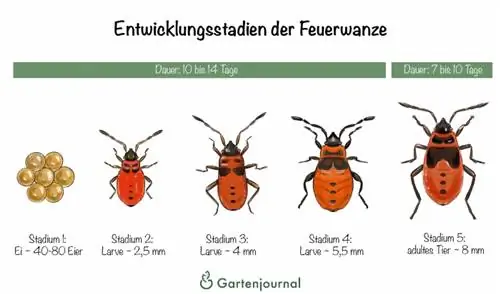
In winter
Fire bugs burrow into the substrate before the onset of winter to protect themselves from the cold. The bugs also live socially during the winter. More than a hundred bugs can often be seen under stones and bushes or in piles of leaves, forming clumps. Temperatures of -5 °C do not cause any problems for the animals in these aggregations. The insects overwinter in the sexually mature stage. Very rarely, larval stages can be observed in the collections. When the sun warms the ground, the bugs become active again. They look for sunny places to warm themselves.
Related species
The common fire bug is the most common species in the family that exists in Central Europe. Two other species occur here that are much rarer. Most species develop red and orange or yellow to white warning colors. But there are also inconspicuously colored species.
| Pyrrhocoris niger | Pyrrhocoris marginatus | |
|---|---|---|
| German name | missing | occasionally monk bug |
| Coloring | black with yellow wing edges | brownish to black with yellow wing edges |
| Dissemination | Crete | southern regions |
| habitat | on the Cretan Tragacanth | Steppenheiden |
| Special features | occurs exclusively in Crete | lives as a single animal |
Where do fire bugs live?
Fire bugs live primarily on the ground. They seek out sunny places and can increasingly be observed at the base of linden trees. In spring there are gatherings of more than a hundred animals here. Horse chestnuts, acacias and other deciduous trees also represent a preferred habitat that fire bugs inhabit. Occasionally the insects crawl up the stems of low vegetation or tree trunks.
Where fire bugs are native
As average temperatures rise, fire bugs have been able to increasingly spread to more northern regions. So far they have not made it to Great Britain or Scandinavia. The bugs conquered Schleswig-Holstein during the 1940s. In the Alps, fire bugs can be observed at altitudes of up to 1,000 meters.
Natural distribution area:
- Central Europe
- Mediterranean areas
- North Africa
- middle Asia to western Siberia, northern China and Pakistan
Natural enemies
The predators of fire bugs primarily include birds. But because of their warning colors, a hungry bird rarely shows interest in the insects. When they eat their prey, they quickly notice an unpleasant taste. As a defense, fire bugs secrete a secretion that scares away birds and can paralyze insects. The strategies are proving to be very successful, allowing the bugs to spread unhindered.
What do fire bugs eat?
Fire bugs are seed suckers. They look for seeds that have fallen on the ground. The mallow family is the main source of food. Occasionally the bugs suck out living and dead insects. In some cases, dead conspecifics are also sucked out.
Insects show social behavior when searching for food. They work together to open the seeds. Several animals then suck the juice from the grains at the same time, using mouthparts that have been converted into proboscises. They secrete a secretion that dissolves the nutrients in the seed.
This is what fire bugs prefer:
- Seeds of lime, horse chestnut and black locust
- Musk mallow (Malva moschata)
- Shrub marshmallow or hibiscus (Hibiscus syriacus)
- Marshmallow (Althaea officinalis)
- Common hollyhock (Alcea rosea)
Fire bugs in the garden
The insects are perceived by many hobby gardeners as “nuisances” because they appear in large numbers and appear frightening. Since their populations are hardly contained by natural predators, many feel helpless against the supposed plague.
If the range of plants in the garden is right, new generations of fire bugs will settle every year. However, they are not harmful to plants as they only target fallen seeds. The supposed plant pests can even be beneficial as they also suck in aphids and prevent their uncontrolled spread.

In the cemetery
There are frequent reports of mass accumulations of fire bugs in cemeteries. These observations cause disgust for most visitors and those who are not familiar with the animals' lifestyle quickly become afraid.
But the bedbugs find ideal living conditions in cemeteries in particular. There are often deciduous trees along the roadsides that produce masses of seeds and therefore food for the insects. On the sun-exposed gravestones you will find ideal places to sunbathe. You still don't have to worry about the grave planting.
Other
Fire bugs are interesting creatures that have been the focus of people's attention for centuries. Fire bugs are among the most popular crawling animals among children and are researched with great enthusiasm.
Fire bug - eternal youth
The early larval stages of the fire bug develop a special hormone that significantly influences the development of the larvae. It prevents precocity and ensures that all larval stages are experienced. During research by a Czech scientist, this phenomenon was observed in the final stage of development.
It was only after some time that the researcher discovered the reason. The pots in which the larvae were bred were equipped with special paper. The paper came from various tree species whose wood contains a substance that inhibits development. This ensures that the last larval stage cannot develop further into an adult insect. The larvae continued to grow during the experiment until they finally died of old age.
These tree species contain the substance:
- Balsam fir
- American Larch
- Hemlock
- Yew
Fire bugs in kindergarten
It's not uncommon for little ones to pick up loads of fire bugs from the floor to keep in the children's room. This doesn't always appeal to parents, but playing with the strikingly colored insects doesn't harm the children.
You get to know the way insects live and get to know nature. That's why fire bugs are also on the curriculum in kindergarten. With the help of discovery tours we try to introduce children to biology in a playful way.
Frequently asked questions
Do fire bugs stink?
Fire bugs differ from other bugs in that they have a receded scent gland. Nevertheless, the bugs emit a characteristic smell when they are threatened. This scent is said to deter predators. At the same time, other species are warned of the danger. A fire bug stinks when picked up and squeezed.
At what temperatures do fire bugs die?
Fire bugs are able to survive temperatures below freezing. If the thermometer drops to -7°C, the bugs survive for around 120 days. They can also survive temperatures down to double-digit temperatures, although the mortality rate is then quite high. Studies showed that some fire bugs survived for about 35 days at -10°C.
Why are fire bugs strikingly red-black in color?
Experiments have shown that the coloring has a warning function and acts as a natural protection against predators. This is how fire bugs deceive their natural enemies. Although they are not tasty, they also have very low toxic effects. Songbirds still spurn the bugs. Scientists believe that the birds view the similar-looking knight bugs as a threat and transfer this association to the fire bugs.
How long do fire bugs live?
The lifespan of insects depends heavily on environmental conditions. A sexually mature fire bug can live between two and twelve months. Occasionally the bugs reach a lifespan of two years.
How often do fire bugs reproduce per year?
It depends on the weather conditions. Usually only one generation develops per year in Central Europe, as the females only lay their eggs in late spring and the development until the insect is sexually mature takes up to three months. In particularly warm years, this generation can reproduce in the same year.
Why do fire bugs appear in large clusters?
Fire bugs love warmth and display social lifestyles. They live sociably in groups and share food with each other. Living together has a simple background, as individuals are more likely to survive in large gatherings. It has been proven that societies experience higher temperatures than the surrounding area. The insects warm themselves this way.




